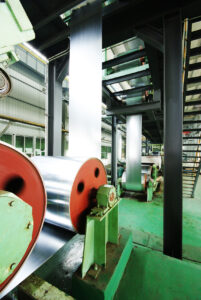Implementing Precise Tension Control in Push-Pull Pickling Lines: Data-Driven Insights
In the steel manufacturing industry, achieving optimal tension control in push-pull pickling lines is essential for maintaining product quality and operational efficiency. This article explores the critical role of tension control, backed by data insights and practical considerations.
Introduction
Push-pull pickling lines are integral to the steel processing chain, preparing steel strips by removing surface impurities through acid treatment. Effective tension control throughout various stages of these lines ensures smooth operation and high-quality end products. The following data outlines typical tension ranges and considerations for different line sections based on steel type, thickness, width, acid bath conditions, and equipment setup.
Typical Tension Data Ranges
- Entry Section:
- Entry Tension: Typically ranges between 50-150 N/mm². This tension ensures straight entry of steel strips into the pickling section.
- Pickling Section:
- Pre-Pickle Tension: Maintained at 100-200 N/mm² to stabilize the strip before entering the acid bath, preventing slack or fluctuations.
- In-Pickle Tension: Kept between 80-150 N/mm² to ensure smooth strip movement during the pickling process, minimizing wrinkles or breakage.
- Rinse and Dry Sections:
- Rinse Tension: Maintained between 100-200 N/mm² to stabilize the strip during rinsing.
- Dryer Tension: Controlled at 120-220 N/mm² to ensure straightness and prevent deformation during drying.
- Exit Section:
- Exit Tension: Controlled between 150-250 N/mm² to facilitate smooth coiling or cutting of the strip, maintaining flatness and dimensional accuracy.
Example of Actual Tension Control Data
Below is a hypothetical example of tension control data across different sections of a push-pull pickling line. Actual values may vary based on specific production lines and process requirements:
| Section | Position | Tension (N/mm²) |
|---|---|---|
| Entry | Entry Tension Roll | 100 |
| Pickling | Pre-Pickle Tension | 150 |
| Pickling | In-Pickle Tension | 120 |
| Rinse | Rinse Tension Roll | 180 |
| Dry | Dryer Tension Roll | 200 |
| Exit | Exit Tension Roll | 220 |
Methods to Obtain Actual Tension Data
- Installation of Tension Sensors: Place load cells or tension sensors at critical positions along the line to monitor strip tension in real time.
- Data Acquisition and Monitoring Systems: Utilize data acquisition systems to collect and monitor data from sensors in real time, enabling operators to adjust parameters promptly.
- Data Analysis and Optimization: Analyze tension distribution data to optimize control parameters and ensure stable operation of the production line.
Adjustments in Practical Applications
- Steel Type Variations: Adjust tension settings based on the type and specifications of steel being processed. For instance, thinner strips require lower tension, while thicker ones may need higher tension.
- Production Speed: Dynamically adjust tension control parameters as production speeds vary to maintain optimal tension levels.
- Equipment Maintenance: Regularly inspect and maintain tension control equipment to ensure its proper functioning and prevent tension fluctuations.
By employing these measures and leveraging real-time data applications, steel manufacturers can achieve precise tension control in push-pull pickling lines, ensuring consistent product quality and operational stability throughout the production process. This data-driven approach underscores the importance of technological integration and continuous improvement in modern steel processing operations.

